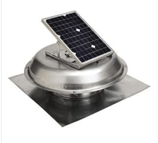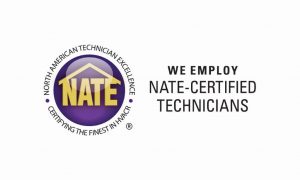 It is no secret that during any given summer day, most attics in Houston can reach temperatures above 150 degrees. This unwanted thermal heat can affect indoor comfort while placing a significant, unnecessary burden on the HVAC system.
It is no secret that during any given summer day, most attics in Houston can reach temperatures above 150 degrees. This unwanted thermal heat can affect indoor comfort while placing a significant, unnecessary burden on the HVAC system.
As hot air rises, it is trapped inside the attic. It is for this reason, just about every home has soffit ventilation coupled with several small vents and gable or ridge vent ventilation. This is called passive or convection ventilation. Unfortunately, this approach, by itself, does not work. To keep all that built-up heat from transferring into the living space of your home, your attic needs a system to proactively remove the heat.
How a Solar Fan Works
Solar attic fans work by pumping the hot air out of your attic. Specifically, a solar panel uses the sun’s heat to produce the energy that powers the fan that blows the hot air out of the attic (see picture below). With a cooler attic, home owners can realize savings up to 30% on air conditioning costs.
Benefits
- Up to 30% Energy Savings
- Quick Payback (6-12 months)
- Qualifies for Federal Tax Credit
- Maintenance Free
- No Operating Costs
The biggest benefit is the reduction in the air conditioning costs. By installing solar powered attic fans, energy savings can be up to 30%. With these significant savings, the typical payback is less than year. Since the fan is solar powered, there is no ongoing electricity cost to power the fan, which means that once installed, there are no further costs associated with the product. Lastly, the solar power attic fan qualifies for a federal tax credit – 30% of the purchase price. In addition to the financial benefit, the solar powered attic fans are maintenance free. There is nothing to adjust and nothing to oil or lubricate.
Key Features
There are several companies that make solar powered attic fans and like all products there are both high and low quality models in the marketplace. The key features to look for are:
- Air Flow (CFM)
- Solar Cell Quality
- Sturdiness
- Adjustable Pitch and Remote Mounting Capability
- Thermostat Integration
The biggest differentiator is how much air the fan can displace — known as the CFM (cubic feet per minute). The lower quality models typically have a lower CFM, which means you might have to purchase multiple fans depending on the attic size. The solar cells themselves differ in quality. Look for a polycrystalline solar panel.
As we live in an area with high winds, tornadoes and hurricanes, you want to purchase a model that can withstand the harshest elements and won’t blow away or crack under these conditions. The better units are sturdier and come with longer warranty periods.
The better models have an adjustable pitch so that the solar panel can be better angled to capture more of the sun’s energy. Furthermore, the advanced models enable the solar cell to be detached from the actual fan. This is ideal for homes that face the south, so you can have the solar panel on the front side of the home, but the actual fan on the back side. Lastly, look for a model that has a thermostat sensor so that it shuts down when a desired attic temperature is reached; for example, in the winter, you don’t want to lose the hot air that is helping to insulate the home.


